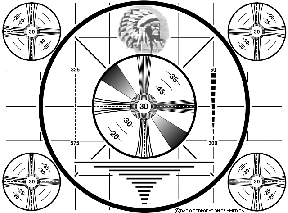
Beginning
Television
I usually got home from school
around 4:15. It was too early for me to watch television:
programming didn’t start until 5:00. I’d always get
something to eat and turn on the TV. All stations ran a
test pattern for about 30 minutes before starting their
evening schedule. The pattern that I remember had an Indian
head at the top of a series of circles. The idea was to let
you adjust the horizontal and the vertical widths so as to
make the circles as round as possible. There was a steady
hum in the background to help you adjust the sound. It was
almost impossible to get the horizontal and vertical
adjustments correct. Usually the images of people had heads
that were too large or too wide. Sometimes the whole screen
would flip to one side and waves of black and gray vertical
lines appeared. This could be corrected by adjusting the
horizontal hold knob. If the screen started flipping
vertically, it could usually be corrected with the vertical
hold knob.
Precisely at 5:00 the test screen would go blank and a live
announcer would appear and welcome everyone to the station.
This was usually followed by either live local news or a
short film. Although most programs were live it was not
unusual for an old western to be shown. There were
commercials scattered during the programming just as there
are today, but not nearly as many. There were no network
programs. Live sports programs, especially wrestling, were
popular.
During the early 50’s there were only 4 channels. Channel 2
was WSB. Channel 5 was WAGA. Channel 8 was the University
of Georgia, broadcast from Stone Mountain. Channel 11 was
WLWA (later WXIA). Sometimes we could get a weak signal
from Macon on Channel 13.
At 11 o’clock each night there was a 15 minute local news
program followed by the playing of the Star Spangled
Banner. The screen would then go blank and the station
would go off the air until the next evening.
It was necessary for each set to have an antenna just as it
is today if cable or satellite is not used. Now almost
everyone has cable or satellite input, so why should
televisions be capable of receiving antenna signals? Maybe
TV’s could be made much cheaper if they could only receive
cable or satellite signals.